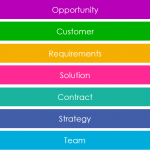 Why did we create the Essential Sales Process (ESP)? Well the answer is that myself, and the other co-creators of ESP, have worked in solution selling for most of our careers, and we felt that most of the available solution selling processes on offer didn’t work very well. They tend to be very linear, and assume a “happy day” scenario where everything goes according to plan, and we always have control over what the customer does, and what the competition does.
Why did we create the Essential Sales Process (ESP)? Well the answer is that myself, and the other co-creators of ESP, have worked in solution selling for most of our careers, and we felt that most of the available solution selling processes on offer didn’t work very well. They tend to be very linear, and assume a “happy day” scenario where everything goes according to plan, and we always have control over what the customer does, and what the competition does.
Firstly, we wanted to create a much more lean and agile sales process, that does not prescribe a strict sequence of activities, but has the ability to adapt and respond to events as they occur. The use of cards and boards is something that is very popular with lean and agile practices, so we wanted to use the same approach. Cards and boards encourage clear visibility of status and progress, and encourage healthy collaboration (we believe selling is a team sport!). Perhaps most importantly, the cards make the process enact-able, unlike a book or manual.
Secondly, we wanted to build in the concept of “continuous qualification”, i.e. qualification is not just something that happens at the start of a sales cycle, but continues throughout the sales process. ESP does this using outcome-based checklists, the result is that the sales people are focusing on the right opportunities, and ensuring all the essential things that need to be done, are being done.
Thirdly, we felt there was often a disconnect between sales management and sales teams. Organisations typically put a sales process in place in order to 1) provide guidance to the sales teams; 2) ensure some consistency and repeat-ability in the sales approach; and 3) ensure that accurate communication can take place between the sales leaders and the sales teams – in particular, accurate forecasting, which is essential to running any business, and a major issue in almost all organisations.
The problem arises when the sales process is too rigid, and sales teams cannot use it because it doesn’t match they way they want and need to work. Then it becomes difficult for sales teams to communicate accurate opportunity status to management, resulting in inaccurate forecasting. ESP solves this challenge by providing practical guidance which sales teams can actually use, and a means to accurately define sales cycle stages, thus removing ambiguity and improving forecast accuracy.
Lastly, we wanted to build something that is holistic, that covers all aspects of the sales cycle, from start to finish: that is, from the earliest possible identification of a potential opportunity, through development and progression of the opportunity, to closure and delivery of the solution to the customer. In other words a process that includes all of the key roles involved in a typical sales cycle: business development, commercial sales, technical sales, and customer success.
ESP was originally offered in the form of physical packs of cards, but we also now offer a digital version which enables tracking of opportunities and visualisation of opportunity status. We also provide training in lean-agile sales process and work with clients to create custom solutions to fit their organisations’ needs – delivering a truly agile, visual, and complete sales process solution that works for everyone – sales managers and sales people alike.
I hope that provides some insight into who we are, what we are passionate about, and why we created ESP. Happy selling!
